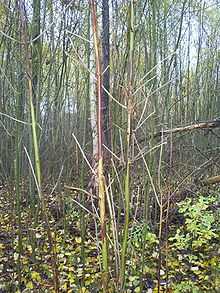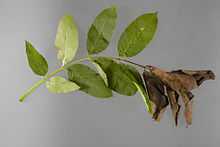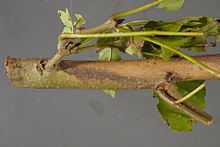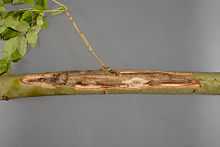Hymenoscyphus pseudoalbidus
| Hymenoscyphus pseudoalbidus | |
|---|---|
| Scientific classification | |
| Kingdom: | Fungi |
| Division: | Ascomycota |
| Class: | Leotiomycetes |
| Order: | Helotiales |
| Family: | Helotiaceae |
| Genus: | Hymenoscyphus |
| Species: | H. pseudoalbidus |
| Binomial name | |
| Hymenoscyphus pseudoalbidus V. Queloz et al. [2011] [1][2] | |
Hymenoscyphus pseudoalbidus is an Ascomycete fungus that causes ash dieback, a chronic fungal disease of ash trees in Europe characterised by leaf loss and crown dieback in infected trees. The fungus was first scientifically described in 2006 under the name Chalara fraxinea. Four years later it was discovered that Chalara fraxinea was only the asexual (anamorphic) stage of a fungus that was subsequently named Hymenoscyphus pseudoalbidus.
Trees now believed to have been infected with this pathogen were reported dying in Poland in 1992. Poland is the country in which ash dieback is believed to have originated. It is now entrenched in Europe. It is closely related to a native fungus Hymenoscyphus albidus, which is saprotrophic and grows on the dead leaves of ash trees.[3][4]
Hymenoscyphus pseudoalbidus
The fungus Hymenoscyphus pseudoalbidus was first identified and described in 2006 under the name Chalara fraxinea.[5] In 2009, based on morphological and DNA sequence comparisons, Chalara fraxinea was suggested to be the asexual stage (anamorph) of the ascomycete fungus Hymenoscyphus albidus.[5] However, Hymenoscyphus albidus has been known from Europe since 1851 and is not regarded as pathogenic.[6] In 2010, through molecular genetic methods, the sexual stage (teleomorph) of the fungus was recognized as a new species and named Hymenoscyphus pseudoalbidus.[5] Although Hymenoscyphus pseudoalbidus is said to be "morphologically virtually identical" to Hymenoscyphus albidus, there are substantial genetic differences between the two species.[7]
The fungus grows during summer on ash petioles in the litter.[6] The ascospores are produced in asci and are transmitted by wind; this might explain the rapid spread of the fungus.[6] It is not known why it has emerged or become so aggressive,[8] but researchers are investigating the theory that the fungus originated in Asia, where ash trees are immune to the disease.[9] Genetic analysis of the fungus Lambertella albida which grows harmlessly on petioles of the Manchurian ash (Fraxinus mandschurica) in Japan, has shown that it is likely to be the same species as Hymenoscyphus pseudoalbidus.[10]
Teams from The Sainsbury Laboratory (TSL) and the John Innes Centre in Norwich sequenced the genome of the fungus in December 2012. The sequence has been published on the website OpenAshDieBack and offers clues to how the fungus infects trees. The study has uncovered toxin genes and other genes that may be responsible for the virulence of the fungus. In the long term researchers aim to find the genes that confer resistance to the pathogen on some ash trees.[11]
Ash dieback

Trees now believed to have been infected with this pathogen were reported dying in large numbers in Poland in 1992,[12] and by the mid 1990s it was also found in Lithuania, Latvia and Estonia.[13] However, it was 2006 before the fungus’s asexual stage, Chalara fraxinea, was first described by scientists, and 2010 before its sexual stage, Hymenoscyphus pseudoalbidus, was described.[12] By 2008 the disease was also discovered in Scandinavia, the Czech Republic, Slovenia, Germany, Austria and Switzerland.[14] By 2012 it had spread to Belgium, France, Hungary, Italy, Luxembourg,[15] the Netherlands, Romania, Russia, Britain and Ireland.[16][17]
There are few official figures available, but the disease has caused a large-scale decline of ash trees across Poland,[18] and the experience there suggests that in the long term "15 to 20 per cent of trees do not die, and show no symptoms."[19] In 2012, the disease was said to be peaking in Sweden and Denmark, and in a post-decline (or chronic) phase in Latvia and Lithuania.[8] The disease was first observed in Denmark in 2002, and had spread to the whole country by 2005.[20] In 2009 it was estimated that 50 per cent of Denmark's ash trees were damaged by crown-dieback,[20] and a 2010 estimate stated that 60–90% of ash trees in Denmark were affected and may eventually disappear.[21] The disease was first reported in Sweden in 2003.[22] A survey conducted in Götaland in 2009 found that more than 50% of the trees had noticeable thinning and 25% were severely injured.[22]
A Danish study found that substantial genetic variation between ash trees affected their level of susceptibility.[23] However, the proportion of trees with a high level of natural resistance seemed to be very low, probably less than 5%.[23] A Lithuanian trial based on the planting of trees derived from both Lithuanian and foreign populations of European ash found 10% of trees survived in all progeny trials to the age of eight years.[24]
So far the fungus has mainly affected the European ash (Fraxinus excelsior) and its cultivars, but it is also known to attack the Narrow-leafed ash (Fraxinus angustifolia).[25] The Manna ash (Fraxinus ornus) is also a known host, although it is less susceptible than the other European ash species.[25] Experiments in Estonia have shown that several North American ash species are susceptible, especially the Black ash (Fraxinus nigra), and to a lesser extent the Green ash (Fraxinus pennsylvanica).[25] The White ash (Fraxinus americana) and the Asian species known as Manchurian ash (Fraxinus mandschurica) showed only minor symptoms in the study.[25]
Symptoms and colonisation strategies



Initially, small necrotic spots (without exudate) appear on stems and branches. These necrotic lesions then enlarge in stretched, perennial cankers on the branches, wilting, premature shedding of leaves and particularly in the death of the top of the crown.[26] Below the bark, necrotic lesions frequently extend to the xylem, especially in the axial and paratracheal ray tissue.[27] The mycelium can pass through the simple pits, perforating the middle lamella but damage to either the plasmalemma or cell walls was not observed.[28] The disease is often chronic but can be lethal.[16] It is particularly destructive of young ash plants, killing them within one growing season of symptoms becoming visible.[29] Older trees can survive initial attacks, but tend to succumb eventually after several seasons of infection.[29]
The disease can be confused with another disorder known as "ash dieback" which has been known for many years and is widespread in the UK.[30] The disorder causes crown dieback in mature trees. The cause is unknown but it is thought to be a mainly physical rather than biological condition.[30]
Management
There are currently no effective strategies for managing the disease, and most countries which have tried to control its spread have failed.[9] The removal of trees in infected areas has little effect as the fungus lives and grows on leaf litter on the forest floor.[9] Research at the Swedish University of Agricultural Sciences suggests that the deliberate destruction of trees in an infected area can be counterproductive as it destroys the few resistant trees alongside the dying ones.[31] One approach to managing the disease may be to take branches from resistant trees and graft them to rootstock to produce seeds of resistant trees in a controlled environment.[31] A Lithuanian trial searching for disease-resistance resulted in the selection of fifty disease-resistant trees for the establishment of breeding populations of European ash in different provinces of Lithuania.[24] However, the process of restoring the ash tree population across Europe with resistant trees is likely to take decades.[31]
Ash dieback in the United Kingdom
The fungus was first found in Britain during February 2012 at sites that had received saplings from nurseries in the previous five years.[12] A ban on imports of ash from other European countries was imposed in October 2012 after infected trees were found in established woodland.[32] There are fears that the ban might not be sufficient to stop the progression of the disease and that a large proportion of the 80 million ash trees in the UK could become infected. On 29 October, Environment minister David Heath confirmed that 100,000 nursery trees and saplings had already been destroyed.[9][33] Heath denied opposition suggestions that delay in responding to the disease had been caused by a 30 per cent cut in the Forestry Commission's budget.[33] The government also banned ash imports but experts described their efforts as "too little too late".[34] Currently it is estimated that between 90% and 99% of ash trees in the UK will be killed by the disease.[35]
The UK Government emergency committee Cobra met on 2 November to discuss the crisis.[36] A survey of Scottish trees started in November 2012.[37] DEFRA, which is facing legal action over allegations that it was too slow to block imports, stated that the increase in cases was due to better reporting.[38] The Forestry Commission has produced guidance and requested people report possible cases. A free mobile phone application, Ashtag, is available to help report and identify cases.[36] Developed by the University of East Anglia it will help conservationists target infected areas.[39] Comparisons have been made to the outbreak of Dutch elm disease in the 1960s and 1970s.[40]
On 9 November 2012 the United Kingdom Government unveiled its strategy. Environment Secretary Owen Paterson announced that it was now acknowledged that the disease was here to stay in the UK and that the focus would now be on slowing the spread of the disease. Young and newly planted trees with the disease would be destroyed; however, mature trees would not be removed because of the implications for wildlife who depend on the trees for their natural habitat. The strategy unveiled by Mr Paterson included:
- Reducing the rate of spread of the disease
- Developing resistance to the disease in the native UK ash tree population
- Encouraging the public and landowners to help monitor trees for signs of ash dieback.[41]
In March 2013 the Environment Secretary Owen Paterson announced that the United Kingdom Government is to plant a quarter of a million ash trees in an attempt to find strains that are resistant to the fungus responsible for ash dieback.[42]
Ash dieback in Ireland
On 12 October 2012 the Department of Agriculture, Food and the Marine confirmed the first recorded instance of the fungus in Ireland, at a plantation in County Leitrim.[43] Legislation was introduced in both Northern Ireland and the Republic of Ireland on 26 October banning the importation and movement of ash plants from infected parts of Europe.[43] By 23 September 2013, a survey conducted by the Irish Government revealed that the disease had been identified at ninety-six sites across the Republic of Ireland.[44]
The first cases in Northern Ireland were confirmed at five sites in counties Down and Antrim on 16 November 2012.[45] By 4 December 2012 the disease had been confirmed at sixteen sites in counties Down, Antrim, Tyrone and Derry.[46]
See also
References
- ↑ "Hymenoscyphus pseudoalbidus (ash dieback)". Invasive Species Compendium. CAB International. Retrieved November 3, 2012.
- ↑ V. Queloz, C. Grünig, R. Berndt, T. Kowalski, T. N. Sieber & O. Holdenrieder (2011). "Cryptic speciation in Hymenoscyphus albidus". Forest Pathology 41 (2): 133–142. doi:10.1111/j.1439-0329.2010.00645.x.
- ↑ Gross, A.; Grünig, C. R.; Queloz, V.; Holdenrieder, O. (2012). "A molecular toolkit for population genetic investigations of the ash dieback pathogen Hymenoscyphus pseudoalbidus". Forest Pathology 42 (3): 252. doi:10.1111/j.1439-0329.2011.00751.x.
- ↑ Brian Spooner; Peter Roberts (1 April 2005). Fungi. Collins. p. 246. ISBN 978-0-00-220152-0. Retrieved 31 October 2012.
- ↑ 5.0 5.1 5.2 "FRAXBACK – Category: Chalara". FRAXBACK. Retrieved 31 October 2012.
- ↑ 6.0 6.1 6.2 "Hymenoscyphus pseudoalbidus". ETH – Forest Pathology and Dendrology. 14 April 2010. Retrieved 31 October 2012.
- ↑ Bengtsson, S. B. K.; Vasaitis, R.; Kirisits, T.; Solheim, H.; Stenlida, J. (2012). "Population structure of Hymenoscyphus pseudoalbidus and its genetic relationship to Hymenoscyphus albidus". Fungal Ecology 5 (2): 147–153. doi:10.1016/j.funeco.2011.10.004.
- ↑ 8.0 8.1 "Decline of Fraxinus excelsior in northern Europe (2010–2012)". SNS – Nordic Forest Research Co-operation Committee. Retrieved 31 October 2012.
- ↑ 9.0 9.1 9.2 9.3 "Are Europe's ash trees finished?". New Scientist. 31 October 2012. Retrieved 31 October 2012.
- ↑ Zhao, Y.; Hosoya, T.; Baral, H.; Hosaka, K.; Kakishima, M. (2012). "Hymenoscyphus pseudoalbidus, the correct name for Lambertella albida reported from Japan". Mycotaxon 122: 25. doi:10.5248/122.25.
- ↑ Ash fungus genetic code unravelled – BBC News
- ↑ 12.0 12.1 12.2 "Chalara dieback of ash (Chalara fraxinea)". Forestry Commission. Retrieved 27 October 2012.
- ↑ "Ash decline in Nordic and Baltic countries". Metla. 3 July 2007. Retrieved 6 November 2012.
- ↑ "Eschensterben alarmiert Forstexperten" (in German). Spiegel Online. 6 November 2008. Retrieved 29 October 2012.
- ↑ Cf. p. 35-36 in: Garnier-Delcourt, M., G. Marson, Ch. Reckinger, B. Schultheis & M.-T. Tholl, 2013. Notes mycologiques luxembourgeoises. VII. Bull. Soc. Nat. luxemb. 114 : 35-54. (Pdf 6.5 MB)
- ↑ 16.0 16.1 "Chalara fraxinea – Ash dieback". European and Mediterranean Plant Protection Organization. March 2012. Retrieved 29 October 2012.
- ↑ "Chalara ash dieback outbreak: Q&A". BBC News. 29 October 2012. Retrieved 31 October 2012.
- ↑ Vasaitis, R.; Lygis, V. (2008). "Emerging forest diseases in south-eastern Baltic Sea region". Network of Climate Change Risks on Forests (FoRisk): SNS Workshop, Umea, Sweden.: 14–15.
- ↑ Cole Moreton (11 November 2012). "Ash dieback: the ruined Polish forest where deadly fungus began". London: The Telegraph. Retrieved 17 December 2012.
- ↑ 20.0 20.1 "Udryddelse truer asketræet" (in Danish). Naturstyrelsen. 6 June 2012. Retrieved 9 January 2013.
- ↑ "Workshop on Chalara fraxinea – Oslo, Norway, 2010-06-30/07-02". European and Mediterannean Plant Protection Organization. 2010. Retrieved 6 November 2012.
- ↑ 22.0 22.1 "Den senaste om askskottsjukan". Svenska Trädföreningen. 2010. Retrieved 6 November 2012.
- ↑ 23.0 23.1 "Ash trees that can survive the emerging infectious die-back disease". NBforest.info. 9 February 2010. Retrieved 31 October 2012.
- ↑ 24.0 24.1 Pliūra, A.; Lygis, V.; Suchockas, V.; Bartkevičius, E. (2011). "Performance of twenty four European Fraxinus excelsior populations in three Lithuanian progeny trials with a special emphasis on resistance to Chlara fraxinea". Baltic Forestry 17 (1): 17–34.
- ↑ 25.0 25.1 25.2 25.3 "Update on ash dieback (Chalara fraxinea) in Europe: New confirmed hosts and description of the perfect state". North American Plant Protection Organisation. 10 November 2010. Retrieved 6 November 2012.
- ↑ Bakys, R.; Vasaitis, R.; Barklund, P.; Ihrmark, K.; Stenlid, J. (1 April 2009). "Investigations concerning the role of Chalara fraxinea in declining Fraxinus excelsior". Plant Pathology 58 (2): 284–292. doi:10.1111/j.1365-3059.2008.01977.x.
- ↑ Schumacher, J.; Kehr, R.; Leonhard, S. (1 September 2009). "Mycological and histological investigations of Fraxinus excelsior nursery saplings naturally infected by Chalara fraxinea". Forest Pathology 40 (5): 419–429. doi:10.1111/j.1439-0329.2009.00615.x.
- ↑ Dal Maso, E; Fanchin G; Mutto Accordi S; Scattolin L; Montecchio L (December 2012). "Ultrastructural modifications in Common ash tissues colonised by Chalara fraxinea". Phytopathologia Mediterranea 51 (3): 599–606.
- ↑ 29.0 29.1 "Chalara dieback of ash – Questions and Answers". Forestry Commission. 16 October 2012. Retrieved 29 October 2012.
- ↑ 30.0 30.1 "Pest Alert – Ash dieback disease". Forestry Commission. Retrieved 5 November 2012.
- ↑ 31.0 31.1 31.2 Tom Rowley (2 November 2012). "Trees that thrive amid killer fungus hold secret to saving threatened ash". London: The Telegraph. Retrieved 4 November 2012.
- ↑ David Batty and agencies (27 October 2012). "Ash tree ban may be too late to avert 'UK tragedy', says expert". London: The Guardian. Retrieved 29 October 2012.
- ↑ 33.0 33.1 "Ash dieback: 100,000 trees destroyed to halt spread". BBC News. 29 October 2012. Retrieved 29 October 2012.
- ↑ Steven Swinford (30 Oct 2012). "British public could be banned from forests to save ash trees from fungus". London: Daily Telegraph. Retrieved 31 Oct 2012.
- ↑ Cormier, Z. (2012). "UK unveils plan to fight deadly ash disease". Nature. doi:10.1038/nature.2012.11790.
- ↑ 36.0 36.1 "Ash dieback: Government Cobra meeting to tackle disease". BBC News. 2 November 2012. Retrieved 2 November 2012.
- ↑ "Ash dieback disease: Survey of Scottish tree stocks launched". BBC News. 4 November 2012. Retrieved 5 November 2012.
- ↑ "Ash dieback: Government faces possible legal action". BBC News. 5 November 2012. Retrieved 5 November 2012.
- ↑ "Ash dieback: App developed to track diseased trees". BBC News. 29 October 2012. Retrieved 2 November 2012.
- ↑ Tracy McVeigh and Josh Layton (27 October 2012). "More forest sites infected as ash disease takes hold". London: The Observer. Retrieved 29 October 2012.
- ↑ Kinver, Mark; McGrath, Matt (9 November 2012). "Owen Paterson: Ash dieback will not be eradicated". BBC News. Retrieved 9 November 2012.
- ↑ "Government to plant 250,000 trees to beat ash dieback". BBC News. 26 March 2013.
- ↑ 43.0 43.1 "Ash dieback present in Co. Leitrim – statutory and voluntary measures introduced". National Biodiversity Data Centre. Retrieved 5 November 2012.
- ↑ http://www.agriculture.gov.ie/forestservice/ashdiebackchalara/
- ↑ "Ash disease discovered at five Northern Ireland sites". BBC News. 16 November 2012. Retrieved 29 November 2012.
- ↑ "Ash disease outbreaks in Northern Ireland stand at 16". BBC News. 4 December 2012. Retrieved 12 January 2013.
External links
| Wikimedia Commons has media related to Hymenoscyphus pseudoalbidus. |
- Ash dieback: Spotter's guide and maps, BBC
- Symptoms guide to Ash dieback disease, Forestry Commission
- Chalara dieback of ash (Chalara fraxinea), Forestry Commission
- Information pertaining to ash-dieback (Chalara fraxinea) work at Fera, Food and Environment Research Agency
- FRAXBACK, Federating scientists for a comprehensive understanding of Fraxinus dieback in Europe
- Open Ash Dieback
- Eichhorn, Markus (October 2012). "The Ash Dieback Problem". Test Tube. Brady Haran for the University of Nottingham.